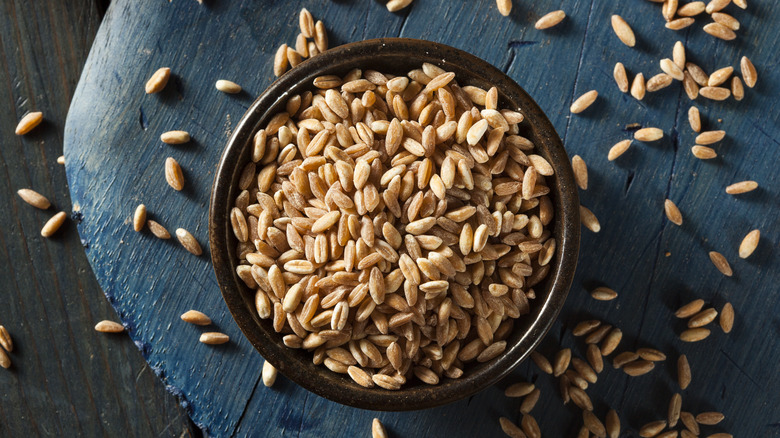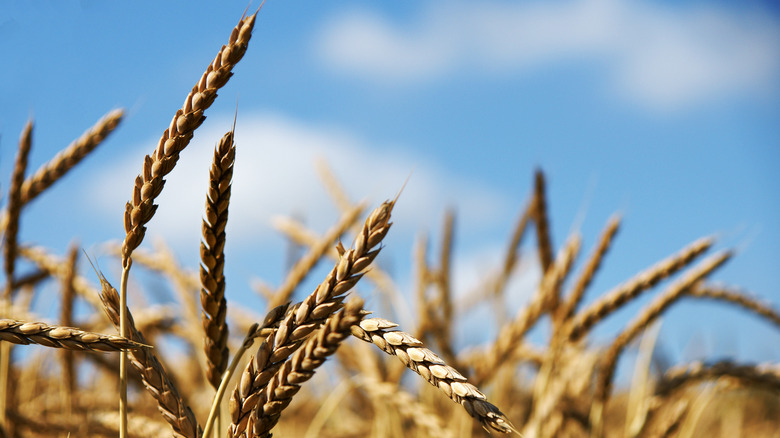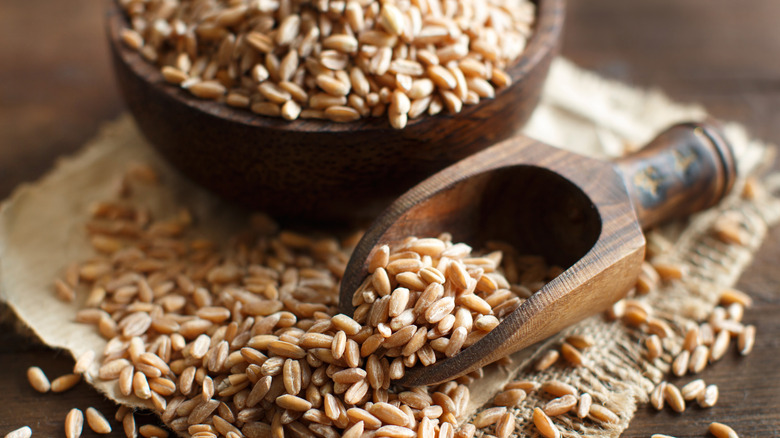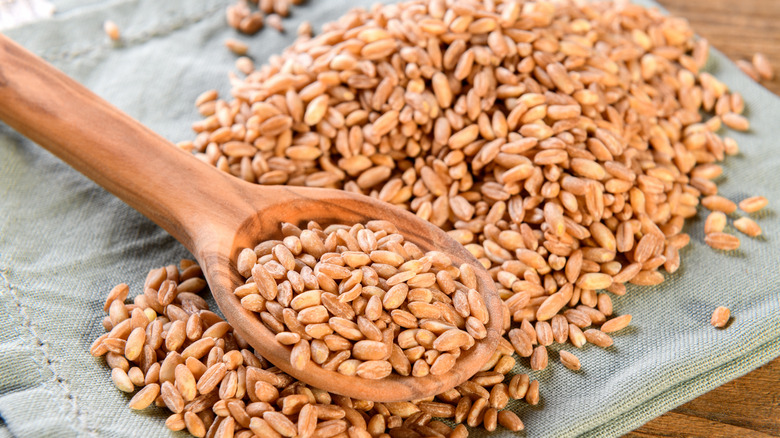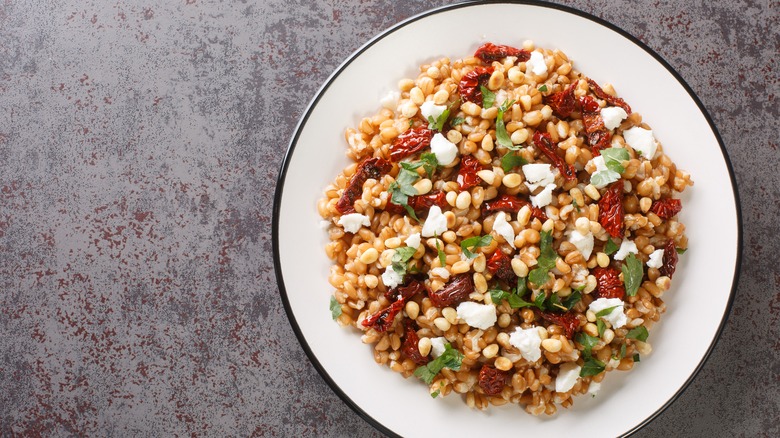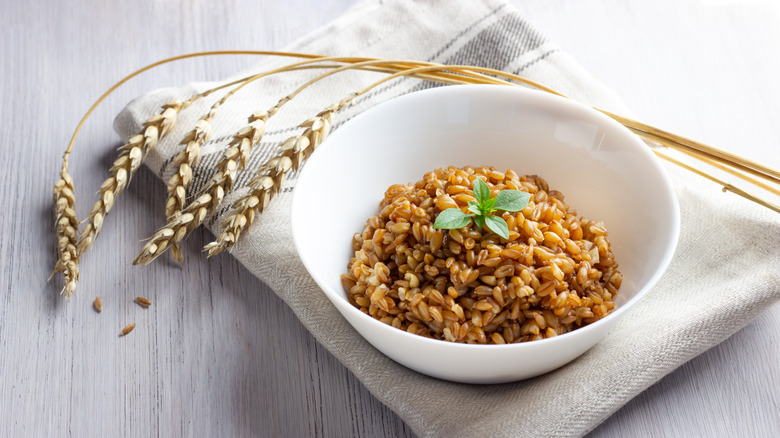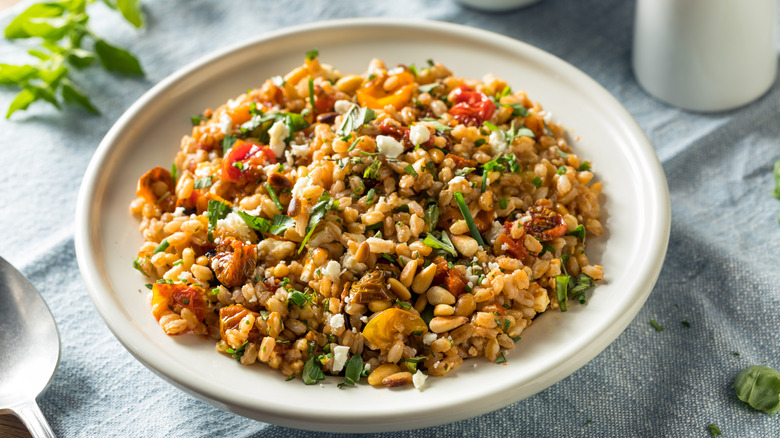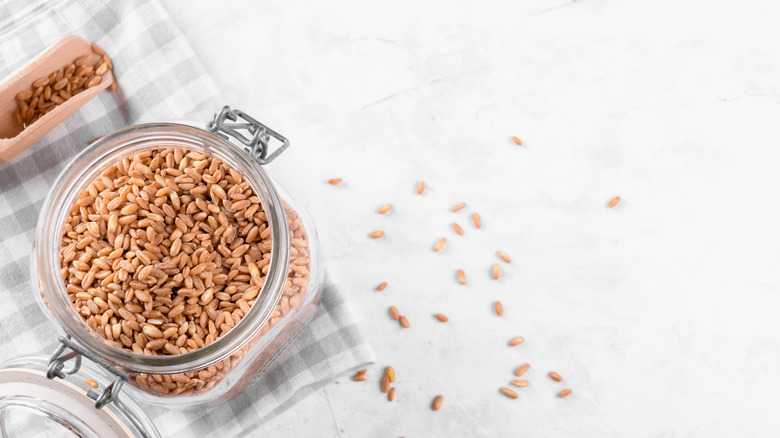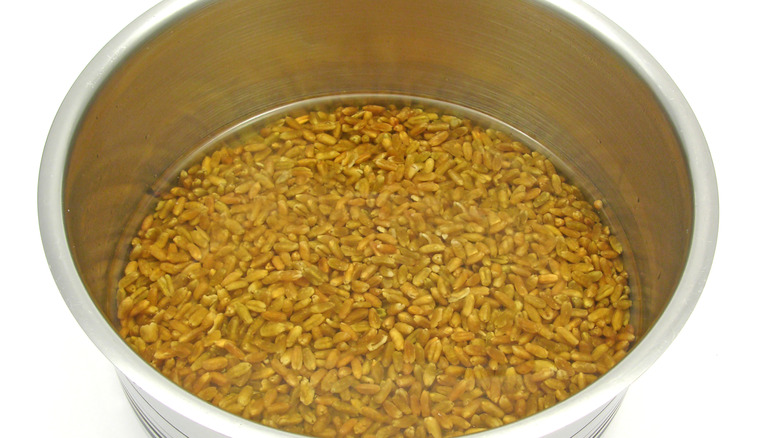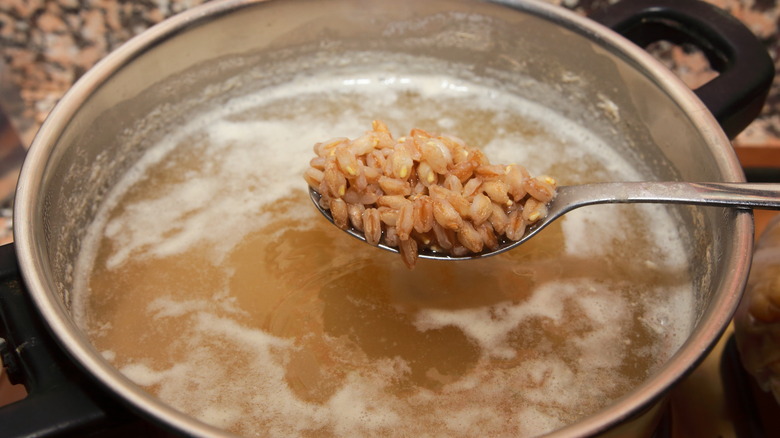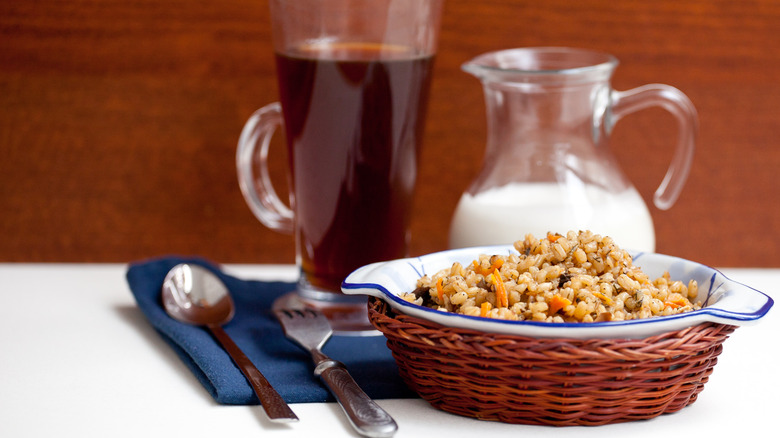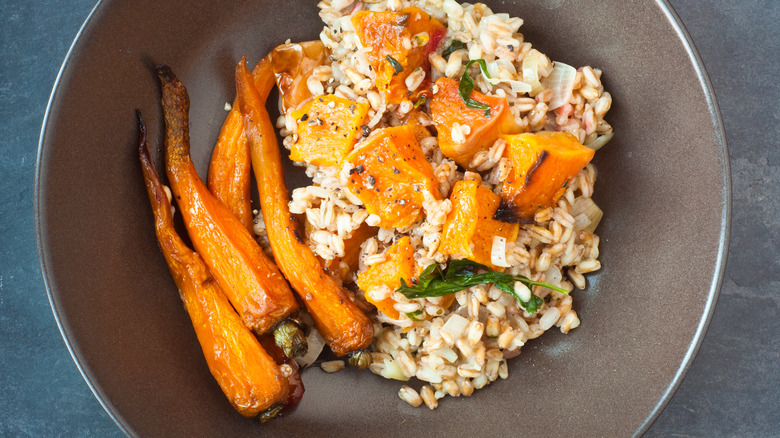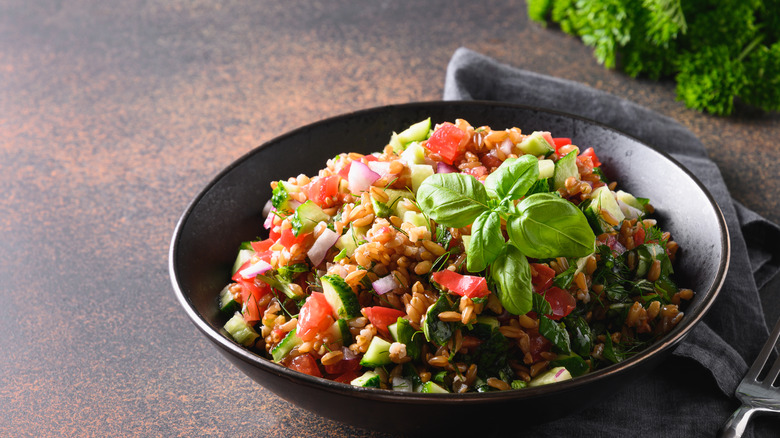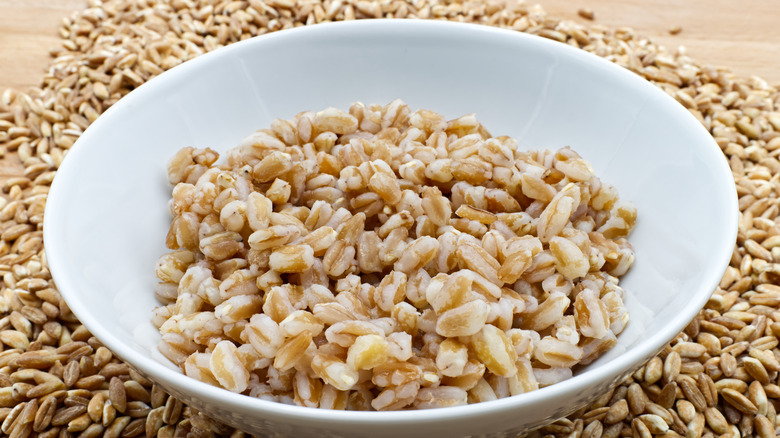Your Guide To Farro: The Ancient Grain That Should Be On Your Radar
Farro is the grain that you may or may not have had to Google when you came across it on an upscale restaurant or gastropub menu. Although it's not readily available in every grocery store, it's an ancient grain that should be on your radar. There has been a fast-growing interest in ancient grains that has helped Americans explore options beyond brown and white rice, and farro is rising in popularity alongside quinoa and buckwheat.
It is versatile, loaded with nutrients, and has a deep history regarding human development and agricultural practices. While most ancient grains are often referred to as cereals, farro can be eaten at any point in the day, alongside vegetables, meats, and salads. You can even find farro in soups or less commonly, in baked goods.
It can be rather simple to make, and whipping up a batch is a great way to switch up your grain game if you've fallen into a predictable rut. Boost any dish that calls for rice with this complex grain, and enjoy the extra flavor, heartiness, and variety that comes along with it.
It is an ancient grain with a rich history
Originating in the Fertile Crescent, farro has been enjoyed by ancient civilizations throughout time and was first domesticated tens of thousands of years ago. Its first historic recording is that of it in the ancient tombs, thought to feed those who had transitioned to the afterlife. Later, it made its way to the Roman Legions to help sustain the armies. It has since spread its way all over the world and has recently risen in popularity in America, although it's often thought of as a Mediterranean grain.
Farro is classified as an ancient grain, which means that it has been grown the same way for several hundreds of years. On the flip side, the majority of mainstream grains have been genetically altered and bred to grow faster, more efficiently, repel pests, or even yield a more productive crop. These ancient grains are less common, and therefore add biodiversity to the food market, which is predicted to help ease future food shortages around the world.
Farro refers to three grains
This ancient grain has stumbled into our hearts, but there may still be quite a bit of mystery and confusion involved when selecting the type of farro to buy. What could be so confusing about purchasing a grain? Well, farro, like many ancient grains encompasses a variety of species. You may not have heard of farro, so it may surprise you that it is actually a kind of wheat. In fact, farro refers to three specific species of wheat including ein-korn, emmer, and spelt.
Emmer is quite commonly grown in Italy, although spelt is better known in America. You may have even seen it as an ingredient in your bread or pasta, and like any ancient grain, it's quite pure because it hasn't been crossed with any other wheat. Spelt berries, on the other hand, are not berries at all but are the kernels of spelt. They have a nutty flavor and are used in the same way you'd use any other grain, and are also encompassed by the title of farro.
It can be processed three ways
Farro can be a rather confusing grain because it can have a different appearance based on how it's been processed. Not all farro is created equal, and each version has a different flavor, different nutrient content, and requires different cooking methods. The three ways to process farro include the whole grain version, semi-pearled farro, and pearled farro.
As you might imagine, whole grain farro contains every bit of the grain and is the most nutrient-dense and flavorful version. Semi-pearled has had some of the bran removed, which is the outer layer. The bran typically has quite a bit of fiber, so semi-pearled fiber may provide fewer digestive benefits and slightly less flavor. Pearled farro has had all of the bran removed and is the easiest to cook, but of course, contains even less fiber and flavor. It's important to know the distinctions because, for example, if you were to try and cook whole grain farro as you would pearled farro, you'd be boiling that grain for hours and hours to no avail.
Farro is a flavorful grain
If you've never had the opportunity to taste farro, then you've been missing out. It's often found in salads and soups because it holds together nicely, and even if slightly overcooked won't dissolve or become overly starchy. It is reminiscent of a short grain brown rice or even steel cut oatmeal once cooked, but looks more like a cross between flaxseed and long-grain brown rice with warm brown coloring.
It's chewy in texture, and quite hearty, especially if you go for the whole-grain variety. It becomes more tender as the bran is removed, but is still quite a robust grain. It tastes similar to brown or wild rice, although has nuttier undertones. Because of its earthy, semi-sweet flavoring, it pairs beautifully with land, sky, and sea proteins, as well as vegetables from all parts of the world. Although it is traditionally used in Mediterranean cuisine, it can be used in place of rice for most recipes. This includes curries, sushi, burritos, and more.
It's quite nutritious
There's another important reason that farro should be on your radar other than just the delicious flavor and versatility. It, along with many of the other ancient grains, is loaded with health benefits. "Nutrients" is farro's middle name, as it's jam-packed with iron, protein, fiber, and magnesium.
Especially for those on a vegetarian or vegan diet, iron and protein are important nutrients to incorporate into everyday meals. Fiber, on the other hand, is a nutrient that only 5% of Americans get their daily dose of, per The National Library of Medicine. Whole grains, especially farro, have digestible fibers that aid in digestive health, as well as balance gut microbiomes. The result reaches beyond just stomach health to heart health, mental health, and even better quality of sleep . In addition, fiber helps to regulate the introduction of glucose into the bloodstream, preventing spikes and crashes. For those looking for an overall boost in health, try adding this ancient grain into your diet, especially the whole-grain version of farro.
It's not suitable for every diet
Although many grains, especially those labeled as "ancient grains," get a reputation for being gluten-free and a cohesive part of any diet, this is not always the case. Unfortunately, that is not the case as farro is not suitable for many popular diets.
Because farro is a variety of wheat, it is not considered gluten-free. In fact, those on a gluten-free diet need to look for more than just wheat on the labels of processed foods. Barley and rye are also often overlooked as gluten-containing grains, but for those with an allergy or sensitivity, it's important to do your research or look for that GF label. Those on a keto diet should also avoid the carbohydrate-rich grain. Luckily, those looking to lose weight should consider indulging in the protein and fiber-rich grain, and perhaps even consider it a healthy replacement for refined grains. Since farro is a grain, vegans, and vegetarians are welcome to load up on it, and can consider it a great source of nutrients.
Find it in the bulk section
Ever discover a unique food product on the internet like tarro or starfruit and spend an eternity trying to find it? In some cases, the only way to get your hands on it is to order it direct-to-customer online, or even travel to its place or origin if you'd like to try it fresh. It can be frustrating but don't give up hope. As demand grows in your area, they will eventually be more accessible.
Because ancient grains have only recently spiked in popularity, it may be difficult to find farro at your local grocery store. In fact, you may have better luck at a co-op or health food market. Consider looking in the bulk food section near other types of popular grains. You may come across at least one variety. Often, grocery stores have a healthy food section, and if you're lucky they may carry farro in pre-sealed bags, right next to quinoa or barley. In fact, name brands like Bob's Red Mill carry farro, so if the grain section of your grocery store is stocked, you may be in luck. When in doubt, ask a member of the customer service team at your local grocery store if they would consider stocking it, and they might just listen.
Store it dried
Storing up on grains for your end-of-world bunker? You may want to consider thinking again. Contrary to popular belief, grains do not last forever, and after a certain period of time, they can become tough and difficult to cook properly. In addition, grains stored in less-than-favorable conditions can grow mold, or even smell rancid.
Typically dried grains can last for about six months after harvest if stored properly. Once cooked, they typically last up to five days in the refrigerator, although typically taste best when enjoyed within three days. If your cooked farro dries out in the refrigerator, consider using it to make fried rice, which typically holds its form best when made with cooked grains that have sat for a few days and hardened.
The absolute best way to store fresh dried grains is in a dry, cool place. Moisture is easily absorbed by grains (remember how you are supposed to place electronics in dried rice if they get wet?) so try to find an airtight container that will keep your farro dry. Keeping grains sealed in a container in the refrigerator, wine cooler, or even freezer which can help to extend their shelf life.
It's optional to soak the farro overnight
If you blindly go into cooking up a batch of farro, you might find yourself cooking it for hours and hours to no avail. While it will eventually cook, there is a quicker way to get there. The first method is to spring for pearled farro, which is not as hearty and takes less time to cook than whole grain. If you're set on whole grain or semi-pearled farro, understand that it is best prepared when soaked. The easiest way to soak farro is to place the grain in a bowl covered with cool, fresh water, cover the bowl, and let it sit overnight. But before you get started, rinse your ancient grain until the water runs clear.
In addition to softening the grain, soaking it will help to reduce the phytic acid. Once it's reduced, farro is easier to digest and allows the nutrients to be more easily absorbed by the body. Adding a splash of acid like lemon juice or apple cider vinegar will help to aid this process further, especially if you only have a few hours for soaking.
Cook it like you would most grains
After the farro has been rinsed and soaked for at least a few hours, it's time to get cooking. It's not entirely essential to toast the ancient grain, but it can help to release that nutty flavor that makes farro so distinctive and delicious. To do this, simply toss your soaked and strained grain in a hot pan with a little oil until it starts to smell fragrant and nutty, which should only take five or six minutes. You'll need to be sure the farro is relatively dry before toasting, to use a paper towel or cloth if needed to absorb moisture.
To keep things simple, try the basic cooking method that works for just about any whole grain. It's simple and straightforward, and there is no measuring required. Simply cook your grains like you would pasta. Remember that like pasta, grains expand, and farro will more than double in size once cooked. For two people, add about one cup of dried, or soaked farro to boiling water and cook until it's tender. At that point, pour it through a fine strainer and serve. We recommend using vegetable broth, salting the water, or adding a little butter or olive oil to enhance the flavor. If you'd rather slow cook it in the correct amount of water, use a 1:3 ratio, meaning one cup of dried farro to three cups of liquid. Slow simmer until all of the liquid is absorbed and serve hot or cold.
Enjoy it as a hot breakfast
Ancient grains are often categorized as cereals, and what better way to start your day than with nutritious, stick-to-your-ribs food? Any grain can be made into a breakfast porridge, but farro is especially delicious because of its nutty undertones and hearty texture. It's also a great way to use leftover grains from a previous recipe and will carry you through your day.
Simply prep the farro as needed, for instance, soak if you're using semi-pearled or whole-grain farro with the bran. Refrain from soaking the grain with any acid like lemon juice, as it may curdle if you plan to add dairy milk. Cook farro in either water, milk, plant-based milk, or a combination. Add your favorite porridge ingredients like raisins, chopped dates, walnuts, maple syrup, cinnamon, almond slivers, or pure vanilla extract. Be sure to include a dash of sea salt or a dollop of butter to enhance the flavor. Once the liquid is absorbed, top with cream or plant-based cream, fresh fruit, whipped cream, or any topping you'd like. For a heartier breakfast, stir in almond or peanut butter or ground flaxseed. Farro will certainly hold you over better than Chex or Cheerios!
Make risotto with farro
Yes, you could make risotto with arborio rice like every other person, but why be basic when you could let your culinary creativity shine? Switch it up for a heartier grain, one with ancient roots and a distinctive flavor. Simply soak your farro if needed, toast it in a little oil, and then cook it like you would risotto, with a flavorful broth. Add cheese, cream, or cashew cream to make it creamy, and don't forget to include aromatics, seasoned vegetables, and proteins.
Consider the fact that because farro carries its own flavor it won't taste like your average risotto recipe. You may consider using less flavoring, and pairing it with gamey meats and vegetables like hen of the woods mushrooms or quail. Luckily, farro complements almost any meat or vegetable beautifully but tastes especially good with strong umami flavors and hearty textures. Be sure to finish with fresh herbs and cracked black pepper.
Toss it into a salad
Most commonly on a menu, you'll find pearled farro in a salad. This is because farro is a hearty grain that holds its shape and can bulk up a bowl of delicate leafy greens instantly. It's just as delicious when enjoyed chilled, and absorbs dressings and spices beautifully. In fact, these little pearls of flavor can be a welcomed addition to both cold and warm salads.
Simply cook your farro until tender, let it cool to room temperature, or chill it overnight, and fold it into dressed leafy greens. If you'd like to make a warm salad consider pairing farro with robust greens like massaged kale, arugula, or collard greens. Use a warm vinaigrette and fresh herbs to top it all off. If you'd like farro to be the main feature of the salad, mince your dark leafy greens and fresh herbs before adding them to a hefty bowl of mostly grain. Be sure to dress heavily, and add some texture with toasted nuts, seeds, raw veggies, or dried fruits.
Batch cook and freeze it
Yes, we can admit that farro is a rather finicky grain to cook, especially if you decide to go the whole grain or semi-pearled route. Instead of rinsing, soaking, toasting, and simmering time and time again, consider batch cooking it and freezing individual portions for later use. These portions can be defrosted and used in soups, warm salads, or even main dishes but do best when reheated or flavored.
To batch cook farro, follow a few important steps to avoid mistakes everyone makes when freezing leftovers. Start by cooking your ancient grain until it becomes tender perfection. Then, lay it out flat on a sheet pan or serving tray until it cools. You'll want to make sure it's at least room temperature because steam can cause excess moisture which will crystalize in the freezer. Lightly spoon single-servings into freezer baggies and label them with the ingredients, the date cooked, and the date it was frozen. Add a disclaimer that it contains gluten if you have any gluten-intolerant family members, roommates, or friends that frequently dine with you or raid your refrigerator.
Lay the baggies flat in the freezer, and do not stack them to allow each bag to freeze as quickly as possible. Once they are frozen, you can stack them, or organize them on their sides like books on a shelf to save space. Enjoy within a few months of freezing by defrosting in the refrigerator and then heating it until warm.
